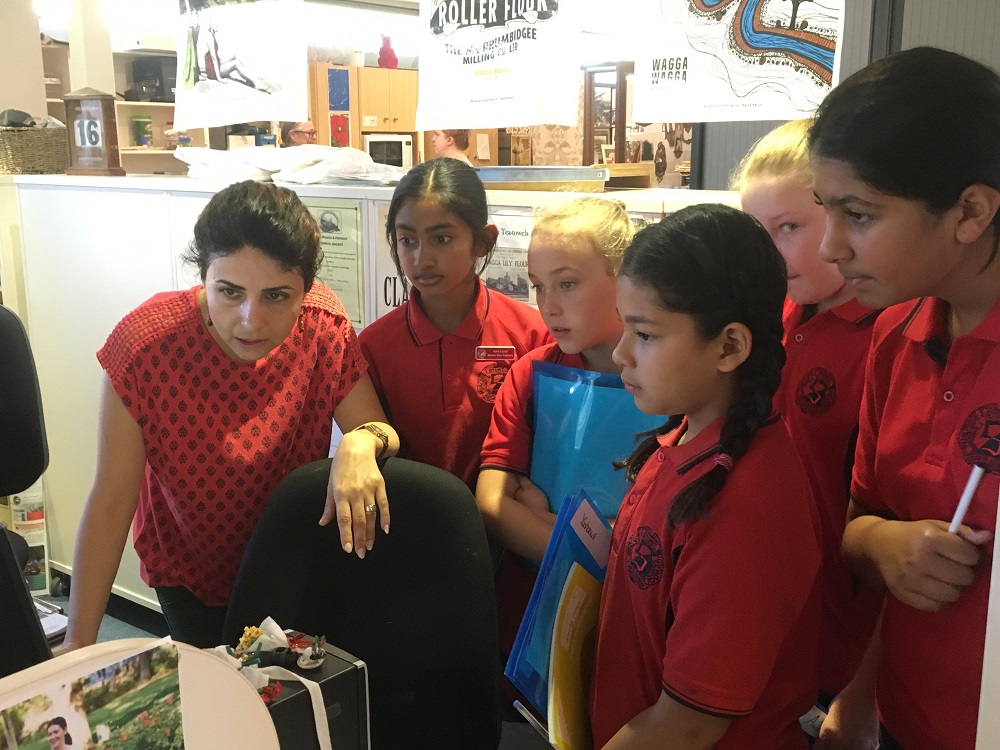Exploring the Collection at MoR
16 March 2018
Today, the junior curators spent some time researching like curators. Searching for objects, thinking about design, hitting dead ends and starting over. Although we know a lot about the form and topics, we don't know the details of how our exhibition will look at the end. It will be shaped by our research and the decisions we make along the way.
To start our investigations, we headed up to the Museum of the Riverina to look at some of the collection and search the database. The Museum’s collection of over 25,000 objects is not currently digitised or accessible online. This situation has been a big challenge for us, not only in STEAM the Museum but also during the curation of Roaming around the Riverina. However, we did not want this to be an excuse to not go ahead with the project. Most regional museums don’t have their collections online, and many major museums only have a portion of their collection online. Therefore, finding a way around this was a good opportunity to model interaction. To overcome this for Roaming, the junior curators researched Trove and provided us a list of topics that interested them. We then collated some images from the collection, which they used to curate their frames. They also made use of other collections which were online, such as CSU Regional Archives, the Australian War Memorial, State Library of NSW, and Trove through the National Library of Australia. This worked well for a small image based exhibition, but for STEAM the Museum we wanted to let the junior curators have more interaction with the collection and to be more in charge of their own research.
We began by looking at a few objects from the collection. Some of the ideas we had discussed during our brainstorming session included fashion, writing and greeting cards. So we brought out some objects to allow the junior curators to look and hold some of these objects. This included a writing slate from the nineteenth century, and a greeting card collected by a soldier from Wagga serving on the Western Front in France during the First World War.
After we had talked about these objects and passed them around, each group was given a task to undertake while we were at the Museum. These centred around researching the collection, either through displays or on our database. Each group is at very different stages in their project, but mostly they are at a point between 'define' and 'ideate'. The Prototyping group is very clear and firmly in the ideate stage. They spent their time researching objects in the collection around the theme of fashion.

Leila helps the Exhibition group to search for objects from the collection.
Other groups are still trying to find the best topic or approach to take. For example, the video-game group spent their time discussing time periods, looking through the different galleries to find some common ground. The 3D printing group looked at broken or incomplete objects that we have on display, and came up with some ideas about what types of objects they would like to work with.

Tim works with the 3D printing group
Each student took notes or photos to document their discussions. It will be a few weeks before we can come back to this research, so it was important for them to keep notes on what they talked about so that they have a firm base to move forward on in Term 2.
After spending time in the galleries, we had one last task. Everyone had to find a display case and sketch what they could see. Not so much the objects, but the layout. How high were the plinths? Where were the labels in relation to the objects? How high or how low? This was to encourage them to think about the aesthetics of exhibition design. Every group will have a display in the exhibition, but most of their planning will happen off-site. Thinking spatially and planning will help us when it comes time to plan for our displays.
And so ended a very busy 90 minute excursion to the Museum!